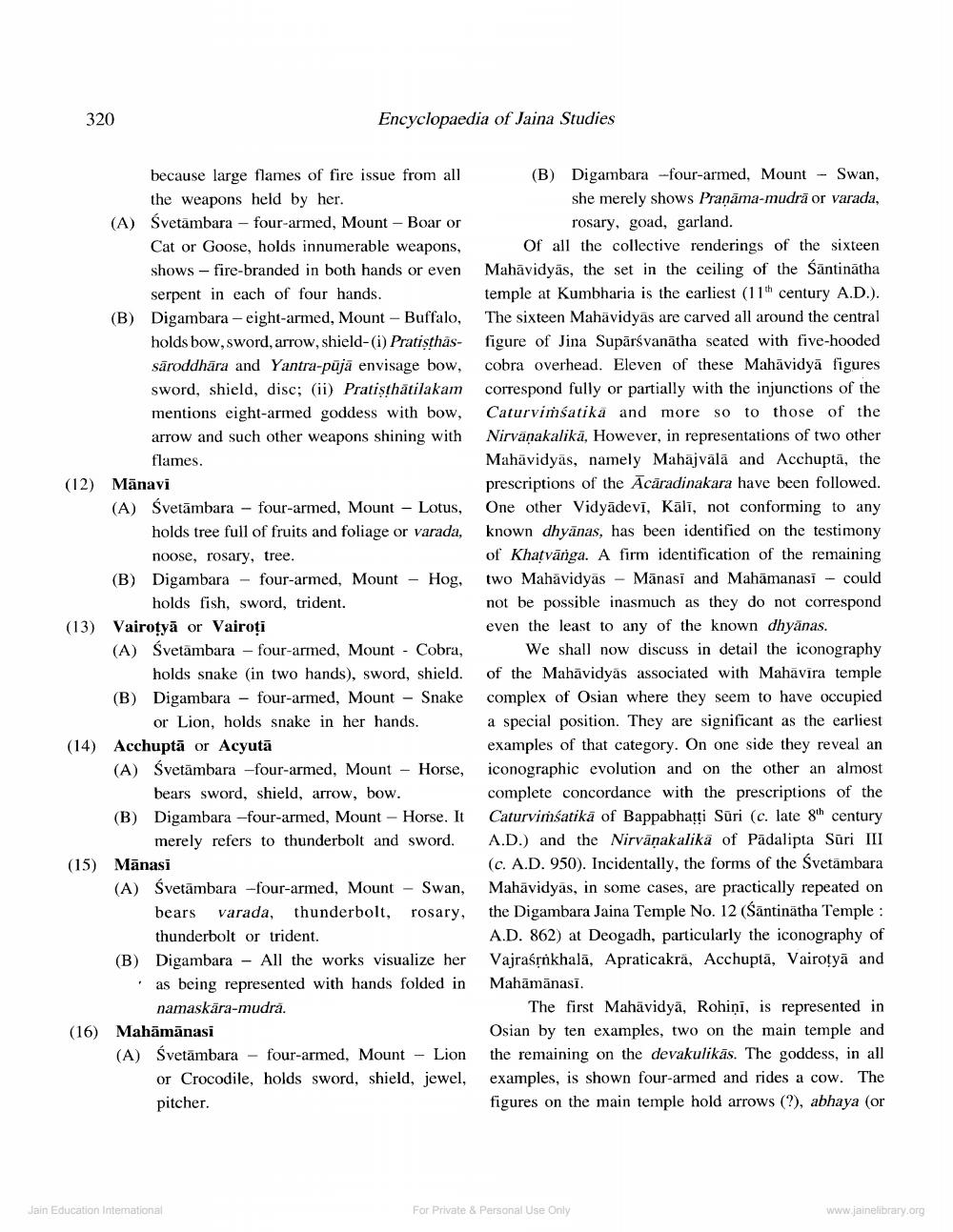________________
320
Encyclopaedia of Jaina Studies
because large flames of fire issue from all
the weapons held by her. (A) Svetāmbara - four-armed, Mount - Boar or
Cat or Goose, holds innumerable weapons, shows-fire-branded in both hands or even
serpent in each of four hands. (B) Digambara-eight-armed, Mount - Buffalo,
holds bow, sword, arrow, shield-(i) Pratisthas- sāroddhāra and Yantra-pujā envisage bow, sword, shield, disc; (ii) Pratisthātilakam mentions eight-armed goddess with bow, arrow and such other weapons shining with
flames. (12) Mānavi (A) Svetāmbara - four-armed, Mount - Lotus,
holds tree full of fruits and foliage or varada,
noose, rosary, tree. (B) Digambara - four-armed, Mount - Hog,
holds fish, sword, trident. (13) Vairotyā or Vairoți (A) Svetāmbara - four-armed, Mount - Cobra,
holds snake in two hands), sword, shield. (B) Digambara - four-armed, Mount - Snake
or Lion, holds snake in her hands. (14) Acchuptā or Acyutā (A) Svetāmbara -four-armed, Mount - Horse,
bears sword, shield, arrow, bow. (B) Digambara-four-armed, Mount - Horse. It
merely refers to thunderbolt and sword. (15) Mānasi (A) Svetāmbara -four-armed, Mount - Swan,
bears varada, thunderbolt, rosary,
thunderbolt or trident. (B) Digambara - All the works visualize her
as being represented with hands folded in
namaskära-mudra. (16) Mahāmānasi (A) Svetāmbara - four-armed, Mount - Lion
or Crocodile, holds sword, shield, jewel, pitcher.
(B) Digambara --four-armed, Mount - Swan,
she merely shows Praņāma-mudrā or varada,
rosary, goad, garland. Of all the collective renderings of the sixteen Mahāvidyās, the set in the ceiling of the Sāntinātha temple at Kumbharia is the earliest (11h century A.D.). The sixteen Mahavidyas are carved all around the central figure of Jina Supārsvanātha seated with five-hooded cobra overhead. Eleven of these Mahāvidyā figures correspond fully or partially with the injunctions of the Caturvimśatika and more so to those of the Nirvanakalikā, However, in representations of two other Mahāvidyās, namely Mahajvälā and Acchuptā, the prescriptions of the Acāradinakara have been followed. One other Vidyādevī, Kālī, not conforming to any known dhyānas, has been identified on the testimony of Khatvānga. A firm identification of the remaining two Mahavidyās - Mānasi and Mahämanasi - could not be possible inasmuch as they do not correspond even the least to any of the known dhyanas.
We shall now discuss in detail the iconography of the Mahavidyās associated with Mahāvīra temple complex of Osian where they seem to have occupied a special position. They are significant as the earliest examples of that category. On one side they reveal an iconographic evolution and on the other an almost complete concordance with the prescriptions of the Caturvimsatikā of Bappabhatti Suri (c. late 8th century A.D.) and the Nirvänakalika of Padalipta Sūri III (c. A.D. 950). Incidentally, the forms of the Svetämbara Mahāvidyās, in some cases, are practically repeated on the Digambara Jaina Temple No. 12 (Sāntinātha Temple : A.D. 862) at Deogadh, particularly the iconography of Vajraśşikhalā, Apraticakra, Acchuptā, Vairotyā and Mahämänasi.
The first Mahavidyā, Rohiņi, is represented in Osian by ten examples, two on the main temple and the remaining on the devakulikās. The goddess, in all examples, is shown four-armed and rides a cow. The figures on the main temple hold arrows (?), abhaya (or
Jain Education Intemational
For Private & Personal Use Only
For Private & Personal Use Only
www.jainelibrary.org




